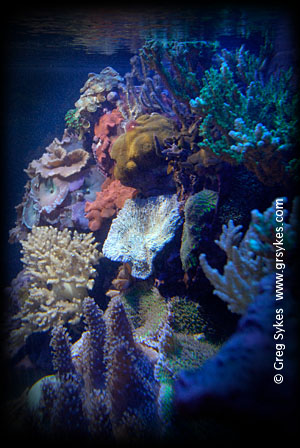Coral Propagation
 In the early marine invertebrate-keeping days, corals and live rock chiseled from the wild reefs were used to stock mini-reef aquariums. Transport stress resulted in many “dead on arrivals.” Adding to the tragedy, inadequate filtration and lighting systems led to an early coral death—usually within months.
In the early marine invertebrate-keeping days, corals and live rock chiseled from the wild reefs were used to stock mini-reef aquariums. Transport stress resulted in many “dead on arrivals.” Adding to the tragedy, inadequate filtration and lighting systems led to an early coral death—usually within months.
By the late-1980’s, technology improved to keep delicate marine animals both alive and thriving1, 2. Full spectrum lighting improved in quality, efficiency, and output: fluorescent bulbs, metal halides, VHOs, power compacts, and T5s now the ubiquitous LEDs. Filtration systems may benefit from chemical filtrations (carbon, phosphate absorbers, polyfilters), but the industry embraces biological filtration: wet-dry filters, live sand, and even improving water circulation around live rock, where biofilms metabolize pollutants. Aquarists cherish protein skimmers (i.e., foam fractionaters).
Today, many corals and other sea creatures happily live and reproduce in artificial settings. Just as gardeners prune vegetation, properly kept coral needs a periodic trim, too. However, these scrapped polyps and cut branches or “frags” can be secured to a shell and grown into a new colony. Many tank-raised coral species and varieties are for sale or available at swaps, rendering the “raping the reefs” practice obsolete. Tank-raising practices extend to other animals, including clownfish and comets; some organisms such as Tridacnid clams are sustainably propagated in tropical facilities3.
BEWARE: some extremely sensitive species (highly specific food requirements, narrow ranges of acceptable water quality, etc.) are best avoided, such as Goniopora sp. and Catalaphyllia jardinei (elegance coral). Fish, such as Platax pinnatus (dusky batfish, long-finned batfish, or red-faced batfish) and Zanclus cornutus (moorish idol) can be equally difficult to maintain. Even experts have trouble keeping these species alive.
NEVER release any aquarium contents into waterways, lest a non-native species or disease establishes, spreads, and damages the indigenous ecosystem. Examples of that scenario abound, both accidentally (Pterois volitans [lion fish] off of the U.S. East Coast) and deliberately (Channa argus [northern snakeheads] released in Potomac River tributaries). Always dispose of aquarium water via sanitation sewer system; in areas without lines leading to sewage treatment facilities, boil water for five minutes before disposing.
You can help coral conservation through responsible reef-keeping. Buy or trade only tank-raised specimens. Research the species you want to obtain before getting them, asking three main questions:
1) Are the water quality, currents, temperature, and light intensity sufficient?
2) Are there any incompatible creatures in the aquarium? In addition to coral-eating fish harming specimens, you don’t want stinging wars between clashing species. Even animals downstream (not in direct tentacle contact) of a melee may suffer from the impacts.
3) Can the food requirements be readily met?
The answers should all be “yes.”
Furthermore, given the state of our oceans, healthy reef aquariums could be mini “Noah’s Arks” in case wild species face extinction. Such is the case with terrestrial species, e.g., Panthera leo leo (Atlas lion). Whereas frags are genetically identical clones from a mother colony, advanced aquarists try to induce coral spawning using environmental stimuli such as altering water currents and simulating lunar cycles. Spawning helps keep populations genetically diverse. Anyone seeking a “challenge” in marine aquariums should investigate coral breeding.
Greg has kept reef tanks continuously ever since he was a teenager and has experimented with many different set-ups and coral-rearing techniques. Currently, he has a 65 gallon aquarium equipped with Dual Orbit Marine IC PRO LED fixtures, four Maxi-Jet powerheads randomly timed on an Ocean Motion wave maker, and a home-made filtration system (protein skimmer, carbon and phosphate-removal chambers, and a wet-dry filter). Oolitic live sand covers the bed; live-frames support the sessile invertebrates.
Links to aquaculture websites
http://www.garf.org/index.shtml
http://www.fragoutpost.com/frag-propagation
http://www.aquaticcommunity.com/corals/propagating.php
Theil, Albert. Small Reef Aquarium Basics (on-line PDF) pp. 118. [View]
Aquarium-related articles authored by Greg Sykes
Sykes, Gregory R. 2007. What is “Live-Framing?” Marine Fish and Reef USA 2008 Annual 10:108-119. [View unedited manuscript]
McClure, Kevin and Gregory R. Sykes. 2001. Relocating the reef aquarium. Freshwater and Marine Aquarium 24(9):152-170. [View unedited manuscript]
Sykes, Gregory R. 1996. Coral culture: an alternative to coral reef harvests. Sea Wind 10(1):2-12. [Text only]
-
- Paper partially reprinted in Sykes, Gregory R. 1997. Coral culture: an alternative to coral reef harvests. Aquarist and Pond Keeper 61(11):6-9.
References
1 Thiel, Albert J. 1988. The Marine Fish and Invert Reef Aquarium. Aardvark Press, Bridgeport, CT. pp. 319. [View]
2 Thiel, Albert J. 1989. Advanced Reef Keeping. Aardvark Press, Bridgeport, CT. pp. 440.
3 Knop, Daniel. 1996. Giant Clams: A Comprehensive Guide to the Identification and Care of Tridacnid Clams. Dahne Verlag, Ettlingen, Switzerland. pp. 255.
Return to Marine Biology Homepage.
